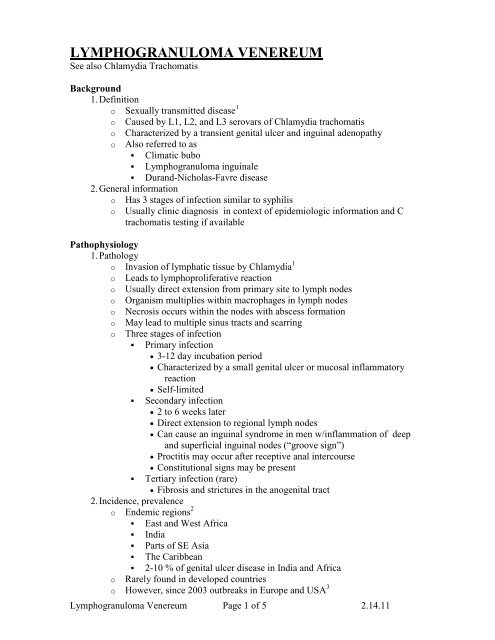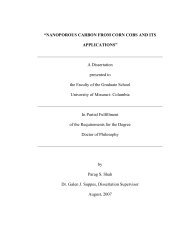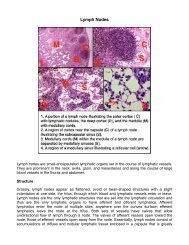Lymphogranuloma Venereum - MOspace
Lymphogranuloma Venereum - MOspace
Lymphogranuloma Venereum - MOspace
You also want an ePaper? Increase the reach of your titles
YUMPU automatically turns print PDFs into web optimized ePapers that Google loves.
LYMPHOGRANULOMA VENEREUM<br />
See also Chlamydia Trachomatis<br />
Background<br />
1. Definition<br />
o Sexually transmitted disease 1<br />
o Caused by L1, L2, and L3 serovars of Chlamydia trachomatis<br />
o Characterized by a transient genital ulcer and inguinal adenopathy<br />
o Also referred to as<br />
Climatic bubo<br />
<strong>Lymphogranuloma</strong> inguinale<br />
Durand-Nicholas-Favre disease<br />
2. General information<br />
o Has 3 stages of infection similar to syphilis<br />
o Usually clinic diagnosis in context of epidemiologic information and C<br />
trachomatis testing if available<br />
Pathophysiology<br />
1. Pathology<br />
o Invasion of lymphatic tissue by Chlamydia 1<br />
o Leads to lymphoproliferative reaction<br />
o Usually direct extension from primary site to lymph nodes<br />
o Organism multiplies within macrophages in lymph nodes<br />
o Necrosis occurs within the nodes with abscess formation<br />
o May lead to multiple sinus tracts and scarring<br />
o Three stages of infection<br />
Primary infection<br />
3-12 day incubation period<br />
Characterized by a small genital ulcer or mucosal inflammatory<br />
reaction<br />
Self-limited<br />
Secondary infection<br />
2 to 6 weeks later<br />
Direct extension to regional lymph nodes<br />
Can cause an inguinal syndrome in men w/inflammation of deep<br />
and superficial inguinal nodes (“groove sign”)<br />
Proctitis may occur after receptive anal intercourse<br />
Constitutional signs may be present<br />
Tertiary infection (rare)<br />
Fibrosis and strictures in the anogenital tract<br />
2. Incidence, prevalence<br />
o Endemic regions 2<br />
East and West Africa<br />
India<br />
Parts of SE Asia<br />
The Caribbean<br />
2-10 % of genital ulcer disease in India and Africa<br />
o Rarely found in developed countries<br />
o However, since 2003 outbreaks in Europe and USA 3<br />
<strong>Lymphogranuloma</strong> <strong>Venereum</strong> Page 1 of 5 2.14.11
Mainly among MSM<br />
Especially those infected w/HIV<br />
3. Risk factors<br />
o Acute infection reported 5 x more often in men than women<br />
o Late complications more common in persons who have receptive anal<br />
intercourse<br />
o Peak age range 15-40 yo.<br />
o Unprotected sex<br />
o Sex in endemic countries<br />
o Multiple sexual partners<br />
4. Morbidity/ mortality<br />
o Complete cure w/early recognition and treatment<br />
o Rarely systemic spread w/arthritis, pneumonitis, hepatitis or perihepatitis<br />
o Third stage of disease can lead to permanent sequelae<br />
Genital deformity (esthiomene)<br />
Lymphatic obstruction with genital elephantiasis<br />
Rectal strictures and fistulas<br />
Death (rare) may be caused by complete bowel obstruction and<br />
perforation<br />
Diagnostics<br />
1. History<br />
o Symptoms<br />
Onset<br />
Location<br />
Duration<br />
Severity<br />
Ask specifically about<br />
Genital or rectal ulcerations<br />
Lymph node swelling<br />
Symptoms of acute proctitis 4<br />
Low-grade fever, chills<br />
Myalgias<br />
Abdominal pain<br />
Rectal pain or bleeding, tenesmus<br />
o Sexual history<br />
New partners<br />
Number of partners<br />
Oral, anal or vaginal penetration<br />
Condom use<br />
Past STD history<br />
HIV status<br />
2. Physical examination<br />
o Look for signs of various stages 1<br />
o Primary<br />
Small painless papule or herpetiform ulcer at site of inoculation<br />
(vagina, penis, rectum or cervix)<br />
o Secondary<br />
<strong>Lymphogranuloma</strong> <strong>Venereum</strong> Page 2 of 5 2.14.11
Large tender usually unilateral inguinal/ femoral lymphadenopathy<br />
also referred to as buboes<br />
Groove sign: enlargement of nodes above and below the inguinal<br />
ligament in inflammation of deep and superficial inguinal nodes<br />
Suppurative or ruptured lymph nodes<br />
Bloody, purulent or mucous discharge from the anus (proctitis)<br />
Large buboes more frequent in men<br />
Women may complain of pelvic pain (inflammation of deep iliac or<br />
perirectal nodes)<br />
Low-grade fever<br />
o Tertiary<br />
Genital scarring with ischemia and tissue necrosis (esthiomene)<br />
Genital elephantiasis<br />
Perirectal abscess, fistulas, strictures<br />
Hyperplasia of intestinal and perirectal lymphatics (lymphorrhoids)<br />
3. Diagnostic testing 4<br />
o Primary<br />
Swab lesion using a Nucleic Acid Amplification Test kit for<br />
Chlamydia 4<br />
Culture can be done but low yield<br />
Serology not useful at this stage<br />
o Secondary<br />
Aspirate buboes for culture or Nucleic Acid Amplification testing<br />
Can do rectal, vaginal or urethral swabs for Nucleic Acid<br />
Amplification testing *<br />
Urine testing with Nucleic Acid Amplification Test<br />
Nucleic Acid Amplification testing<br />
Includes PCR, LCR, TMA, and SDA tests<br />
Does not differentiate between LGV and non-LGV serovars<br />
of Chlamydia<br />
Further identification of a positive test can be confirmed via<br />
the CDC http://www.cdc.gov/std/lgv/LGVflowchart5-22-<br />
2006.pdf<br />
Serology useful if direct detection unsuccessful, but not well<br />
standardized 4 (SOR:C) 5<br />
Complement fixation (CF) for chlaymdia<br />
o Titer > 1:64<br />
Microimmunofluorescence (MIF) test (more specific)<br />
o Titer > 1: 256<br />
o Low titer cannot exclude LGV, high titer in absence of<br />
symptoms cannot confirm LGV<br />
* Nucleic Acid Amplification testing can only be done rectally and orally if approved<br />
by lab being used. Check with lab before sending.<br />
Differential Diagnosis<br />
1. Key DDx 1<br />
o Genital Herpes<br />
o Syphilis<br />
o Chancroid<br />
<strong>Lymphogranuloma</strong> <strong>Venereum</strong> Page 3 of 5 2.14.11
o Granuloma Inguinale (Donovanosis)<br />
o Cat Scratch Disease<br />
o Crohn's Disease<br />
2. Extensive DDx<br />
o Visible strictures from carcinomas<br />
o Tuberculosis<br />
o Infectious Mononucleosis<br />
o Tularemia<br />
o Brucellosis<br />
o Bubonic plague<br />
o Lymphoma<br />
Therapeutics<br />
1. Acute treatment 6<br />
o First line: doxycycline 100 mg PO twice a day x 21 days (SOR:B) 5<br />
o Alternative: erythromycin base 500 mg PO four times a day x 21 days<br />
(SOR:B) 5<br />
o Possible: azithromycin 1 g PO once weekly for three weeks (SOR:C) 6,7<br />
2. Further management<br />
o Pain relief for active bowel inflammation or for painful buboes<br />
o Consider aspiration of buboes to avoid rupture and tract formation<br />
o Incision and drainage<br />
Recommended by some<br />
Others feel it delays healing<br />
o Notify and test all sexual contacts within last 2 months<br />
o Consider other STD screenings, esp. for syphilis and HIV<br />
3. Long-Term Care<br />
o Sexual risk reduction behavior education (SOR:B) 8<br />
o If sequelae present, tailor to those complications<br />
Follow-Up<br />
1. Weekly for 4 weeks or until resolved (Test of cure necessary)<br />
2. Advise sexual abstention until treatment completed and clinical manifestations<br />
resolved<br />
3. Report to local health department<br />
4. Specialty consultation for sequelae<br />
Prognosis<br />
1. Complete cure if treated in primary or early secondary stage<br />
2. Permanent genital tract changes if not treated before scarring occurs<br />
Prevention<br />
1. Reduction of risky sexual behavior (SOR:B) 8<br />
2. Prompt identification and treatment of sexual contacts<br />
3. Condoms probably confer some risk reduction (SOR:C) 1<br />
http://www.cdc.gov/std/treatment/2006/genital-ulcers.htm (link to CDC STD treatment<br />
guidelines 2006)<br />
http://www.cdc.gov/std/lgv/default.htm (link to CDC LGV project)<br />
<strong>Lymphogranuloma</strong> <strong>Venereum</strong> Page 4 of 5 2.14.11
References<br />
1. Sexually Transmitted Diseases. Holmes, et al New York: McGraw-Hill;<br />
2008. <strong>Lymphogranuloma</strong> <strong>Venereum</strong> Chapter 33,pg 595-607.<br />
2. White JA. Manifestations and management of lymphogranuloma venereum.<br />
Curr Opin Infect Dis 2009;22(1):57-66.<br />
3. <strong>Lymphogranuloma</strong> venereum among men who have sex with men--Netherlands,<br />
2003-2004. MMWR Morb Mortal Wkly Rep 2004;53(42):985-8.<br />
4. Herring A, Richens J. <strong>Lymphogranuloma</strong> venereum. Sex Transm Infect 2006;82<br />
Suppl 4:iv23-5.<br />
5. <strong>Lymphogranuloma</strong> venereum (LGV). IN: Sexually transmitted infections:<br />
UK national screening and testing guidelines.<br />
In: National Guideline Clearinghouse; 2008.<br />
6. Workowski KA, Berman SM. Sexually transmitted diseases treatment guidelines,<br />
2006. MMWR Recomm Rep 2006;55(RR-11):1-94.<br />
7. Nieuwenhuis RF, Ossewaarde JM, van der Meijden WI, Neumann HA. Unusual<br />
presentation of early lymphogranuloma venereum in an HIV-1 infected patient:<br />
effective treatment with 1 g azithromycin. Sex Transm Infect 2003;79(6):453-5.<br />
8. Lin JS, Whitlock E, O'Connor E, Bauer V. Behavioral counseling to prevent<br />
sexually transmitted infections: a systematic review for the<br />
U.S. PreventiveServices Task Force. Ann Intern Med 2008;149(7):497-508, W96-9<br />
Author: Grace Alfonsi, MD, University of Colorado FMR Denver<br />
Editor: Robert Marshall, MD, MPH, Capt MC USN Puget Sound Family Medicine<br />
Residence, Naval Hospital, Bremerton, WA<br />
<strong>Lymphogranuloma</strong> <strong>Venereum</strong> Page 5 of 5 2.14.11
















